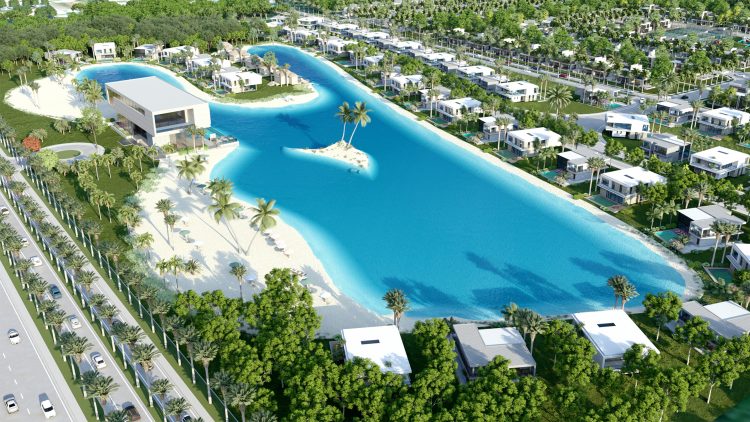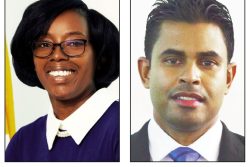Guyanese-American building contractor and developer Danny Sawh plans on investing about US$350 million into the transformation of 100 acres of former Ogle estate lands into a luxury waterfront gated community with a built in lagoon surrounded by state of the art residential properties, green spaces and a commercial area.
“The goal is to deliver, to build a new project even larger than this [Windsor Estates, Providence], on the East Coast…to bring living in Guyana to the next level. You’re going to have lakefront living… and just a better sense of aesthetics, overall aesthetics of the community,” Sawh told Sunday Stabroek News in an interview last week.
“There will be a lagoon, residential properties, single family homes and condos, a clubhouse, a commercial area, wider roads…the development will be such that we will bring to Guyana underground power cables…everything underground so you don’t have wires everywhere. It will be a tranquil space that you want to go home to…,” he added.


Sawh went into details about the project that he believes that many dream about or see in developed countries, thinking it would only be accessible if they leave these shores. However, he said that as Guyana transforms into an oil economy, he wants persons to know that such a community will be established right here and set a bar for living standards.
“It’s quite different. It’s very different obviously because now you have the actual information that is there. We know that due to oil it [the economy] is going to continue to grow. There is going to be a significant increase in GDP. So yes, it’s a lot more comforting now to know that, yes, if we embark on a new project, not to be worried as much about who we are going to sell it to. It was a concern when we started here,” he related.
With land clearing and structural and geological testing continuing at the Windsor Ogle community location for the next year and half, Sawh said that infrastructural works for buildings will not begin until afterward.
When building starts, it will be focused on building the residential units then the commercial zone.
The goal of Valiant Construction, Sawh’s company that will undertake the development, will be to deliver between 500 to 600 residential units, comprising of stand-alone houses, townhouses and condos.
But costs on the units would not be available until construction starts, given that the COVID-19 gave insight into the volatility of housing markets among other investments. “I’m giving ourselves time to figure out what the cost would be before we start pricing and publishing prices for these housing units,” Sawh noted as changing labour costs and other factors must be incorporated into his capital expenditure.
However, he promises that whatever the end figure, Windsor will have some pre-construction deals to offer so that early buying homeowners will be rewarded for their faith in the company.
Humongous challenge
In 2012, when there was no sign of oil and Sawh shared his vision to transform a flooded area in Providence East Bank Demerara into an upscale gated community, many persons laughed at him and no investor would partner with him.
“There were no investors. It was just me… it was just personal money that I put into it to get it started and then eventually we got some local financing by a couple of banks. It was a huge risk, but again, it was it was based on a lot of research by myself in terms of numbers and based, on country reports and projects and what the different scenarios could be,” he said.
However, a decade after seeing the transformation of the lands to high demand homes, he has the Ogle project, but this time his naysayers have changed views and investors are flooding him with calls to buy into his newest development.
“The original concept behind this [Providence] development, it was to try to bring something to Guyana that’s unique and do something quite different and, and try to stay with it to the end .so when we came up with the design plan and came up with all the renders that we did, we kind of published them either through marketing material or on our website. And we used to tell people that this is what we’re going to deliver. People were like, ‘Oh? You guys are not going to do this. This is just again, a dog whistle …where you’re saying, you know, you will make it look fancy and it’s not possible,” Sawh recalled.
But he said that while data even then showed that this country would have a housing boom, he understood that from an investment perspective, he too would have had trepidations. The skepticism of locals was something he said that he also accepted, because the experience of being disappointed by persons time and time again was a reality that Guyanese were traumatized by. “I knew because it’s Guyana, it was what it is. It’s to be understood because of so many projects that were started here and got, you know, developers trying to make a raise but then bail on projects. And as you noticed, there are a lot of abandoned projects around. So we knew we were going to be faced with that challenge of being second guessed,” he posited.
He said that not only did he know that it would be possible, it had been a lifelong dream of his to design and develop an entire community so his heart was committed “to make sure this happens”.
“I wanted to make sure that if we put a vision through, that we do follow through on it. Nobody was sure how the economy would be. It started out great but there was some periods where the economy tanked. And there were some periods when we second guessed if we would be able to finish it. Just from finding financing to getting sales…it was really painful but we had to dig our heels in and say we must get through this period,” Sawh said.
As he recalled the “humungous challenge to make this happen”, he said that persons who are accustomed to one working standard in the United States and then come here expecting it to be the same are sometimes blindsided by the reality that it just is not so.
“From a business point of view, learning all the lessons that we learned here- and boy they were significant lessons! From every level, and from just me, I could I could give you pages on pages or a book of lessons we learned here, you know just doing stuff in Guyana. Much of it is quite unique to Guyana even compared to countries outside of a Western society. So it was every level of learning and adapting and trying to work with what we had. We tried not to work around things because that was something that we insisted with our staff. If we’re going to do something in Guyana, we would not be compromised or … [fall prey to anyone saying] this is the typical way or this is normal here. There was [a] zero bribing policy we had. I said it was a no-no. We’re not going to involve and stuff like that,” Sawh explained.
He said that sticking to the developed world’s standards, guidelines and codes of building led to some time delays and financial losses on his part.
He imports from the United States all his electrical and plumbing fittings and materials that comply with that country’s building codes and guidelines.
An example of no compromise in work, Sawh said, led to his containers sometimes being held for up to six months, thus incurring fees not catered for.
“Those are some of the challenges we dealt with here, but most of the times when it didn’t get worked out in the end, we understood like what are the pitfalls, what were the challenges. So we were able to, over time and over the years, were able to manage some of these things. And again, it’s not only it’s not only in some of the logistics, but it’s also understanding the labour issues in Guyana. It is quite unique compared to the US, where you know here it’s always a concern about people showing up for work for a full week… So we had significant challenges there,” he added.
Oil impact
With oil being discovered offshore Guyana in 2015 and more discoveries to follow, Sawh said skilled labourers became come scarce, creating another setback in the form of competing with wages being offered in the sector. “You’re competing then for that same labour pool that was there prior to prior to 2015. And that hasn’t changed. The labor pool has still stayed the same, except now when there’s more construction happening, we’re still competing with that unit,” he said.
Oil and development here also pushed Sawh into looking at a bigger project, and from 2018 he had been pressing the APNU+AFC government to accept a proposal to develop Ogle from Navigant Builders Inc. Sawh said that he was limited to 30 acres and the company did a sod turning for that development in February of 2020.
But days after the March 2020 general elections, the company announced that it was putting that project on pause because of the “uncertain environment,” a decision it explained was “non-partisan”.
Sawh last week again echoed what the company had said then, as he explained that as a business person, one should leave politics for politicians and focus on work.
Lessons learned
On the financial side, he said that lessons learned and experiences from Windsor Providence are many that he will now take into the new Ogle project.
“In terms of how we did here, I would say I wish we had done better financially. We wanted to do big things that a project like this, there’s major overheads involved. And you know, land cost, development costs, is not about just building the houses or building the building…probably by the time we’re done, it’s going to probably take about four times more than length of time that I had initially budgeted. A lot of our profits were eroded due to the length of time it took, and also the economy had tanked; and you know not being able to do the things we needed to do at the time because if you build it, you couldn’t sell it. So it was kind of a chicken and egg situation we were dealing with.
“Going past that now, like I said, I wish we had done well in this project where we can say well, we met our goals in terms of financial goals but we haven’t. But I think, at this point, we, despite all the frustration we had here, we talked about it…and [are] giving it one more try. We are incorporating all the lessons we’ve learned into a new project. We’ve made some mistakes no doubt; have gained experienced and now knowing the lay of the land, and just learning little things in the rounds we have made…putting all that together, we’re like, hey, we’ll do a new project. This time we will do it from knowing what we know now …and will do something even to a higher end,”
While homes listed as for sale in Windsor Estates now have staggering price tags, Sawh said that those gains were not his company’s but the homeowners who had invested when he first built, for which he is glad. Property costs had ranged from US $135k (GY$28.3M) to US$300k (GY$60M) depending on model, options, land size and location. Some had been sold below cost during the company’s “struggling times”.
Recently, one home owner sold their property in in the community for an eye popping US$1.2 million. Homeowners also currently rent or lease, with prices ranging from US$8000 to US $20,000 per month.
Overall, Sawh said that his record must be judged from Windsor Estates Providence because when evaluation of his delivery on the project is looked at, one would see that all that was proposed has been completed today. “If you go back, everything that we had proposed back in 2012, it turned out pretty much exactly the same as the proposed concept. There are a couple of things we added afterwards to enhance the project. But the goal is, if we are designing and presenting a concept, our goal is to deliver on that…,” he said.
“I am proud we got through and here we are today. Thanks to our staff and their determination. We were able to get this done. I could not have done it without them. Most of the people we have here are people who have been here from day one…and I am grateful,” he added.









